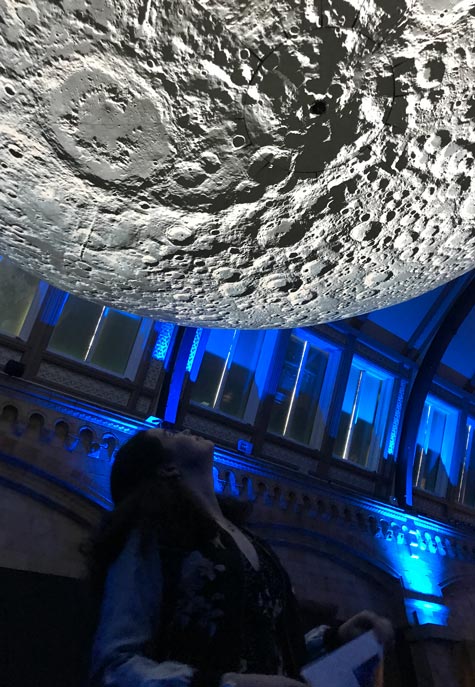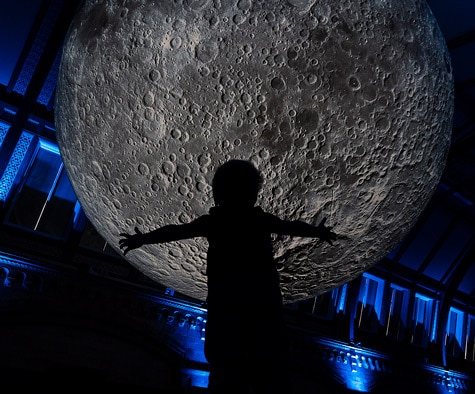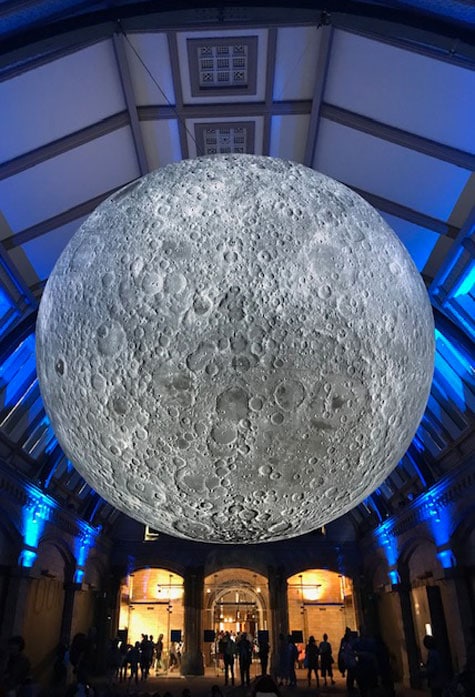Family Traveller’s 15-year-old reviewer, Juno Butler-Cole recommends a trip to see Luke Jerram’s ‘Museum of the Moon’ installation
July 20th marks the 50th anniversary of the Apollo 11 pockmarked landing, the first-time humans set foot on the moon in 1969. I’ve always been fascinated by that first moon landing, avidly watching every movie I could find about modern space travel. I even feebly attempted to write a story about what I felt was the unappreciated third pilot of the Apollo 11 mission, Michael Collins when I was younger. Yes it was terrible, but it had heart.
So when I heard about the new installation, ‘Museum of the Moon’ by the artist Luke Jerram at the Natural History Museum, it was a must see. I’ve attached many happy memories of wandering the dinosaur exhibitions with my grandparents, and many frightening memories of the earthquake demonstration with my father to the Natural History Museum, but I had never thought of it having anything to do with space.
Well it turns out that the museum’s Jerwood Gallery is the perfect place to host this monumental fabric moon. My first thought is just wow! It’s breathtaking, the moody blue lighting, the eerie custom-made sound track floating between static crackles and smooth, pulsing synth flashes in the air. Oh and of course the huge glowing orb floating in the center of the hall! It really makes for quite a sight.

Juno gazes up at Luke Jerram’s moon installation

Young visitor Austin, takes in the awe-inspiring moon
The moon itself is unbelievably detailed. The dips and dents of asteroid craters litter the surface; discoloration of a black, icy colour shrouds the top of this small moon. What could have happened to the real moon to create this effect I wonder?
As if this isn’t exciting enough, when you walk around the other side, you can actually see the dark side of the moon! I was childishly excited by this, and you know what, the dark side of the moon is actually better looking! Bold claim I know, but it’s more consistently pockmarked and a lovely dull, pearly white all over. The moon is captivating, hypnotizing, and you can’t take your eyes off it as it gently sways
Once the socially acceptable viewing is over, it seems everyone’s next move is to lie under the moon, basking in its artificial glow. It’s impossible not to feel the urge to interact with this artwork. On my back, a school group to my left, a young couple to my right, we lie on the floor gazing transfixed at this recreation of a small sphere of rock that is so subtly present in everyone’s collective psyche. What do you associate with the moon?
So this is the question going through my head as we all conglomerate on the carpet under the moon, how heavy is this thing? Well, apparently it’s likely to be quite light as the new moon is actually a globe of inflated material imprinted with high resolution NASA images captured of all the moon’s surfaces. If I couldn’t see the stopper in the bottom, I wouldn’t believe it. Each indent looks real and tangible, not at all like a smooth surface of fabric. If it falls, I think, would it bounce like a beach ball?
The Natural History Museum is free for all visitors, as is the Museum of the Moon installation, open until January 1, 2020. Family yoga classes under the moon are available. Parents and children explore gentle yoga through stories, easy breathing and meditation. Yoga incorporated into a space mission story line keeps the children engaged. £14 per person. Available at 08.45-09.30 on 1, 8, 15, 22 and 29 August, 2019.

See the illusive dark side of the moon